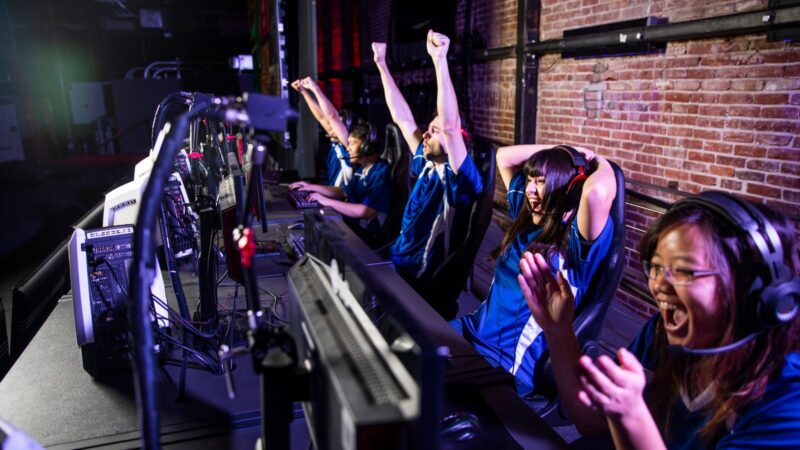

Online gaming has become an integral part of the entertainment industry, growing rapidly over the past decade. What was once a niche hobby has developed into a global phenomenon, catering to a diverse audience with a wide range of preferences. The digital revolution, alongside technological advancements, has reshaped how players engage with games, creating immersive, social, and competitive experiences. As gaming technology continues to evolve, it’s clear that we are entering an exciting new era for both developers and players.
Exploring the Impact of Technology on Modern Gaming Experiences
The evolution of online gaming has been fuelled by technological advancements that have redefined how players interact with digital environments. Faster internet speeds, more powerful gaming consoles, and sophisticated PC setups have allowed developers to create more complex, visually stunning, and highly interactive games. One of the most significant changes in recent years is the shift toward cloud gaming, which allows players to access high-quality games without needing expensive hardware.
Cloud gaming enables players to stream games on various devices, removing the barriers traditionally imposed by physical gaming setups. This accessibility is broadening the gaming demographic, making it easier for casual players to dive into titles previously reserved for those with high-end equipment. As internet infrastructure improves globally, cloud gaming is set to become even more widespread, transforming how players access and enjoy games.
In addition to cloud gaming, the rise of artificial intelligence (AI) in game development has led to smarter, more responsive game environments. AI-driven non-player characters (NPCs) now exhibit more complex behaviors, making gameplay more engaging and unpredictable. Furthermore, AI is also being used to personalize player experiences, learning from an individual’s style of play and adapting game mechanics accordingly.
How Innovation Is Driving New Trends in the Online Gaming World
Innovation in the gaming industry doesn’t stop at technology; it extends to game design and development methodologies. Developers are experimenting with new ways to engage players, leading to the rise of hybrid genres and unique gameplay mechanics. The popularity of “live service” games, which evolve through continuous updates and community feedback, exemplifies this shift. Titles such as Fortnite and Apex Legends regularly introduce new content, keeping players engaged over long periods.
Cross-platform gaming is another trend gaining momentum. With players no longer confined to a single gaming device, cross-play allows them to join the same game, regardless of whether they’re using a console, PC, or mobile device. This breaks down traditional barriers and has helped build large, inclusive gaming communities.

Another notable innovation is the rise of in-game economies. Games like Roblox and Minecraft enable players to create and trade digital goods, often using real-world currencies. These virtual economies add a new layer of depth to gaming, allowing players to monetize their creativity and contribute to the broader game ecosystem. As online gaming continues to evolve, it’s likely that we will see more opportunities for players to blend entertainment with real-world economic activity.
The Rise of Mobile Gaming and Its Influence on Player Behavior
Mobile gaming has grown exponentially in the past few years, reshaping how players approach gaming. As smartphones become more powerful, mobile games are offering experiences that rival those found on traditional consoles. This growth has been particularly evident in the UK, where mobile gaming dominates the online gaming market.
The rise of mobile gaming has also led to the increasing popularity of online slots UK players enjoy, combining quick gameplay with the convenience of playing on the go. Mobile-friendly platforms have made it easier than ever for players to access online slots, giving rise to a new generation of gamers who prefer short, engaging experiences they can enjoy anywhere. The portability of mobile devices has changed how people view gaming, with many players now dipping in and out of games throughout their day rather than setting aside long blocks of time.
This shift towards mobile gaming has also influenced player behavior in terms of social interaction. Mobile games often feature social components, such as multiplayer modes or integrated chat functions, allowing users to connect with friends or compete against strangers. Mobile platforms are blurring the lines between traditional gaming and social media by making gaming a more casual social activity. As this trend continues, we can expect mobile gaming to further redefine what it means to be a “gamer.”
Evolving Player Preferences: What’s Driving the Demand for More Engaging Games
As online gaming grows, so do player expectations. Modern gamers are seeking more engaging and immersive experiences, pushing developers to innovate. Narrative-driven games have seen a resurgence, with players placing a higher value on storylines and character development. Titles like The Last of Us and Red Dead Redemption 2 demonstrate the power of rich storytelling in attracting a dedicated fan base.
Beyond stories, personalization is increasingly important. Players want games that allow them to tailor their experience to their preferences. Whether it’s through customizable characters, adjustable difficulty settings, or the ability to mod games, gamers today crave experiences that reflect their individuality. Developers are responding by incorporating more player-driven choices into their games, offering a sense of ownership and control.
The demand for multiplayer experiences is also on the rise. Competitive gaming, often referred to as eSports, has exploded in popularity, with millions of viewers tuning in to watch professional gamers compete. This demand for shared experiences highlights the shift towards social gaming, where playing with others is as important as the game itself.
The Role of Virtual and Augmented Reality in Transforming Online Gaming
Virtual reality (VR) and augmented reality (AR) are two of the most exciting technological advancements in gaming. VR immerses players in fully interactive environments, while AR enhances the real world with digital elements. Both have the potential to dramatically change how games are played and experienced.

While VR adoption has been gradual due to the high cost of hardware, it’s steadily gaining ground. Games like Beat Saber and Half-Life: Alyx have shown the potential of VR to create truly immersive experiences. In the future, as VR technology becomes more affordable and accessible, it’s likely to become a more mainstream part of online gaming.
AR, on the other hand, has seen widespread success thanks to its integration with mobile devices. Pokémon GO demonstrated the possibilities of AR gaming, encouraging players to explore their real-world surroundings while interacting with virtual creatures. AR’s ability to blend the digital and physical worlds opens up endless possibilities for game developers to create innovative, location-based experiences.
From Casual Players to Competitive Gamers: Shifting Dynamics in the Online Gaming Community
The line between casual and competitive gaming is becoming increasingly blurred. Many players who start as casual gamers are finding themselves drawn into competitive play through games that offer both laid-back and high-stakes experiences. This shift is visible across many genres, from battle royale games like Call of Duty: Warzone to more strategic titles such as League of Legends.
Part of this transformation is driven by the accessibility of online gaming platforms, which make it easy for players to dip their toes into competition without needing to commit full-time. As eSports continues to grow, the gap between casual and competitive play is likely to shrink even further, with more players seeing competitive gaming as a natural progression of their online experience.
The rise of streaming platforms like Twitch has also contributed to this trend, allowing casual gamers to observe and learn from top players. This accessibility has inspired a new generation of competitive gamers, eager to test their skills against others and share their journey with an audience.











